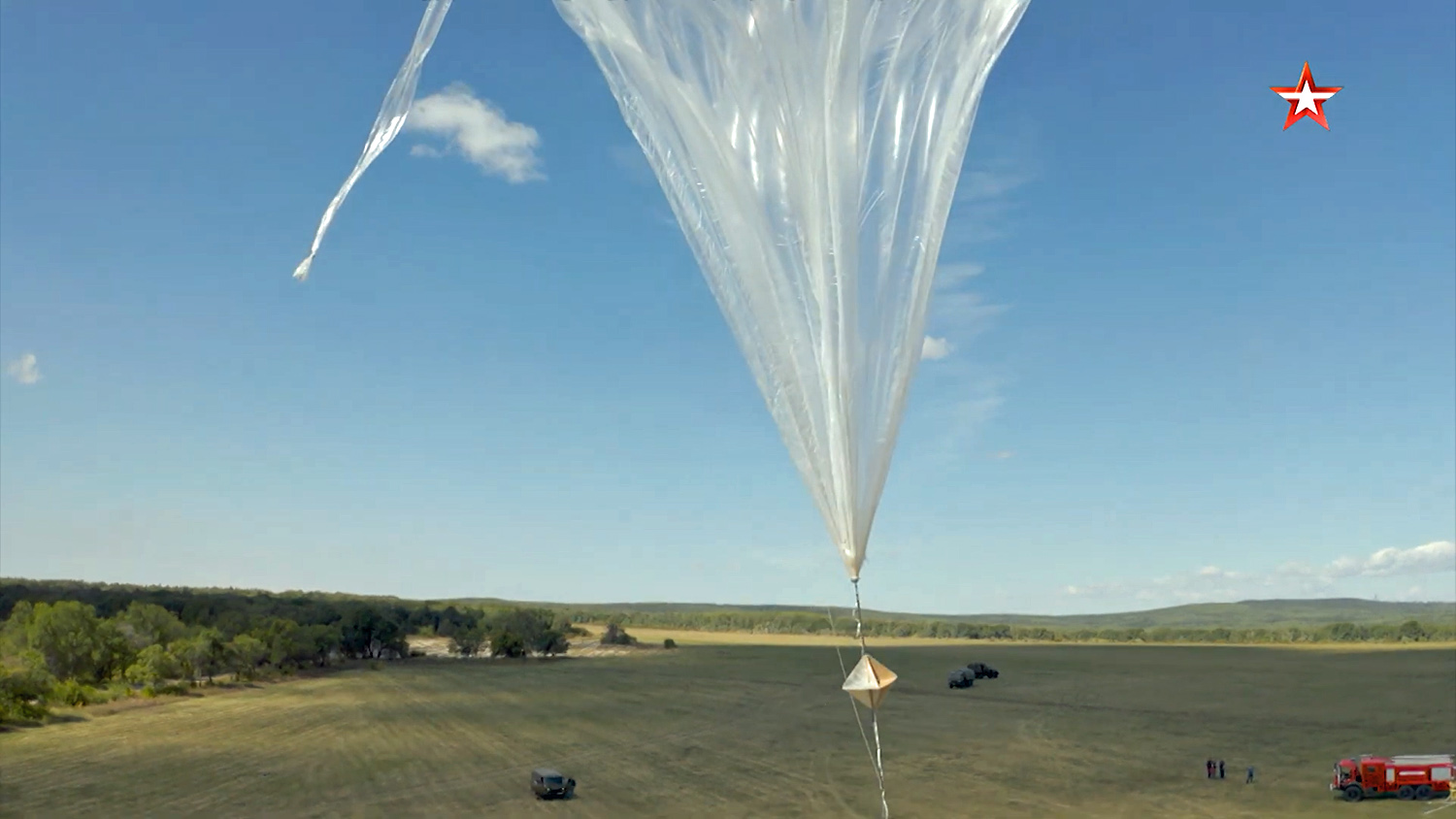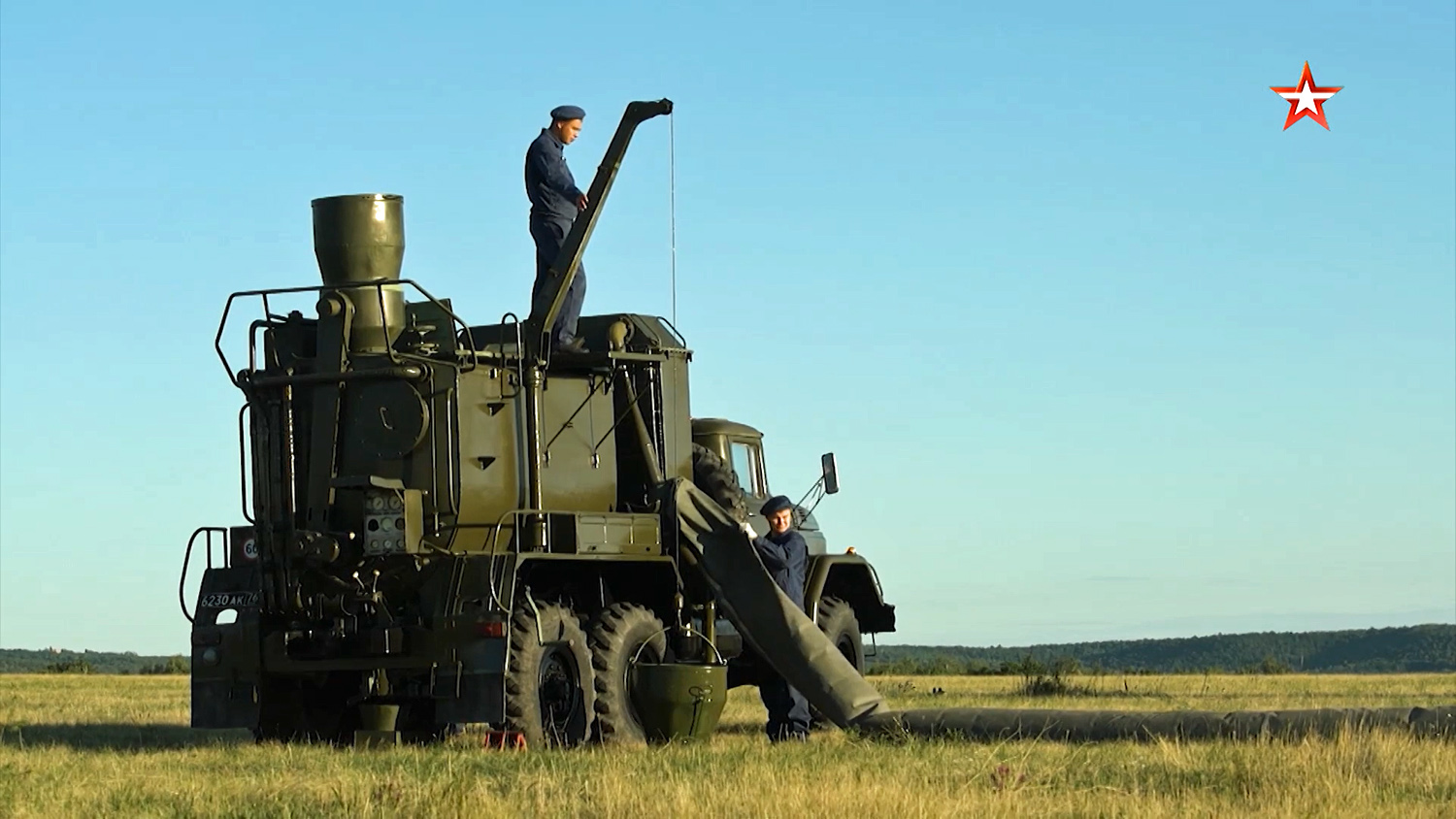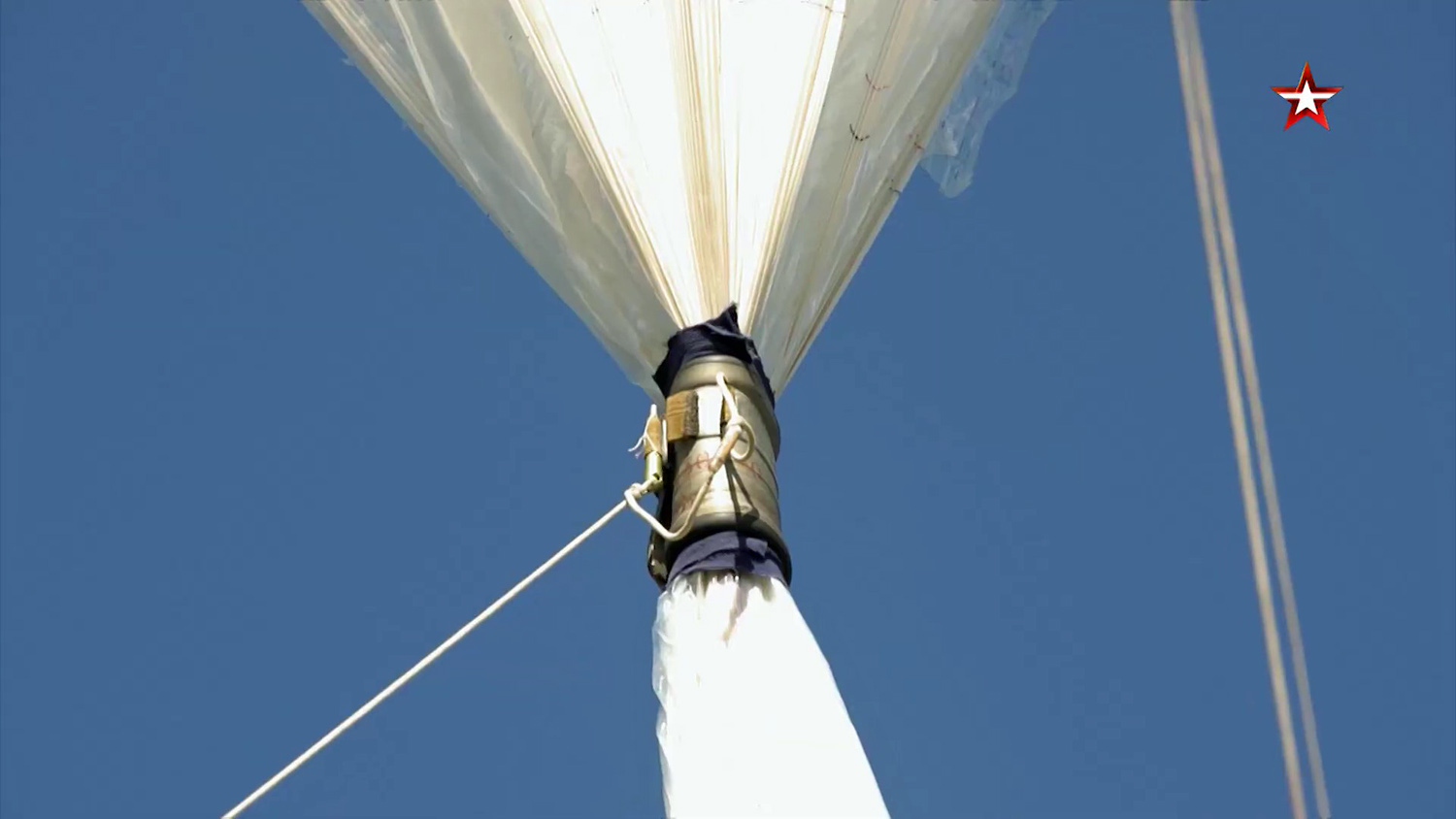Aerostats, including unpowered balloons, were very popular in the Soviet Union before World War II, but subsequently fell almost completely out of favor. However, once the Cold War was underway, Soviet surveillance balloons made a comeback. In the modern Russian military, there remains a limited niche for these kinds of balloons, although, with spy balloons very much back on the international agenda, it’s possible that they could become part of a broader resurgence.
Beginning in the mid-1950s, thousands of free balloons drifted over the Warsaw Pact countries from the west; many of them flew into the territory of the Soviet Union. This was the impetus for the creation of a series of special balloon-intercepting aircraft, which you can read more about here. But it also spurred the Soviets to launch work on their own military balloons. Accordingly, in 1956, the OKB-424 design bureau — also known as the Dolgoprudny Automatics Design Bureau (DKBA) — was established, especially for the task of making new military aerostats.

The first task of OKB-424 was to copy a U.S. photo-reconnaissance balloon that had come down on Soviet territory. Over the next 60 years, DKBA produced around 20 types of free-floating balloon envelopes, with volumes ranging from 11,500 cubic feet to 21,190,000 cubic feet, each of which could carry various kinds of mission equipment. The largest of them was the Ukolka series of balloons from the 1960s, which had a capacity of 21,190,000 cubic feet and could lift a 660-pound payload to an altitude of 147,600 feet.
What does the military use balloons for?
As the Soviets returned to large-scale military balloon use in the Cold War, several primary types became prominent, based on their different missions, and some of them remain in service to this day.
Two combat balloons, the BAB-325 (Boyevoi Aerostat, Blizhniy; combat aerostat, short-range) and BAD-3500 (Dalniy, long-range; the numbers indicate the volume of the balloon envelope in cubic meters), were introduced in 1960, armed with incendiary bombs. The smaller of them carried 220 pounds of bombs, the larger one as much as 2,650 pounds of bombs. The BAB-325 and BAD-3500 balloons were mass-produced by the Rostov-on-Don helicopter plant, today the Rostvertol company.
The AF-3 (Aerostat Fotorazverdchik) photo-reconnaissance balloons were especially widely used. These operated on the ‘boomerang principle.’ After having taken photographs, the balloon returned to its own territory utilizing various airstreams at different altitudes.
The first agitation balloon, or AG-1 (Agitatsionnyi), carried up to 11 pounds of propaganda leaflets and scattered them at a distance of up to 250 miles. The subsequent AG-6M, which is still in service, has a strategic range; it can deliver 120,000 leaflets (weighing a total of 440 pounds) over a distance of up to nearly 10,000 miles and scatter them from a height of 16,000 feet, covering around 50 square miles.
Similar in construction to the agitation balloons, but carrying a different payload, are the ARP (Aerostat Radio-Pomekh) passive jamming balloons that drop chaff — bundles of radar-reflective material that can blind and confuse radars and their operators. Also still in service is a balloon that combines the jamming and agitation functions, the ARP-AGM, which can deliver 220 pounds of chaff or propaganda leaflets up to 620 miles.
Another purpose of these balloons is as targets during exercises or as decoys in conflicts. Soviet balloons were first used as high-altitude targets in air defense exercises in 1961. Small Au-23 target balloons from the Augur company are currently in use for air defense artillery and anti-aircraft missile exercises. Hung under the balloon are corner reflectors with different radar cross-sections, ranging from 19 to 430 square feet, imitating various aircraft.

Recently, reports emerged from Ukraine suggesting that Russian balloons fitted with radar reflectors are being used in the conflict, intended to confuse Ukrainian radar systems. The Ukrainian Armed Forces claimed that several of these balloons had been brought down ahead of an attack by Russian-operated, Iranian-supplied Shahed-type kamikaze drones.
Intercontinental balloons
Beginning in the 1960s, the DKBA developed two large balloons for the military, which are still used today in further improved versions. Both can carry various types of payloads: incendiary bombs, chaff, radio and radiation reconnaissance equipment, target imitators, propaganda materials, and others. The smaller one is the AN-S, where AN stands for Aerostat Nositel, or carrier aerostat, and S stands for Srednevysotnyi, medium-altitude; it can drift for seven days at an altitude of 29,500 to 39,000 feet. In the 1980s, the modernized AN-S1 version entered service.
The larger balloon is the AN-V, for Vysotnyi, high-altitude, which can drift at an altitude of 98,000 feet or more. Later, the related AN-V1, AN-V1A, AN-V1B, and AN-VM versions were created. This last one of these is the largest military balloon currently used in Russia.
Large military free balloons in service in Russia
| Balloon | AN-S1 (izdeliye VE-1) | AN-VM (izdeliye VD) |
| Envelope volume | 70,629 cubic feet (2,000m3) | 6,356,640 cubic feet (180,000m3) |
| Envelope diameter | 51.2 feet (15.6m) | 229.6 feet (70m) |
| Envelope weight | 139 pounds (63kg) | 1,433 pounds (650kg) |
| Suspension weight | 1,543 pounds (700kg) | 4,409 pounds (2,000kg) |
| Useful load weight | 992 pounds (450kg) | 2,315 pounds (1,050kg) |
| Flight altitude | 32,808 feet (10km) | 118,110 feet (36km) |
| Flight endurance | 7 days | 12 days |
Another stratospheric combat balloon is the VAL-120, but the relationship of this to the AN-S and AN-V is not entirely clear. Although its characteristics are close to those of the AN-V/VM, it is a separate project. The VAL-120 MBA (Vysotnyi Aerostat Laboratoriya, high-altitude laboratory aerostat; MBA means Mezhkontinentalnyi Boyevoi Aerostat, intercontinental combat balloon) was developed in the mid-1960s; the modernized VAL-120M was produced in large numbers up until the early-1990s. Somewhat surprisingly, the primary military task of the VAL-120 MBA was to drop incendiary bombs on U.S. territory; for this purpose, a swarm of balloons was to take off from the Kamchatka peninsula in the Russian Far East and fly with the wind to the east.
Interestingly, this is the only large balloon still advertised by DKBA. It is shown on the DKBA website with the name VAL (without the number 120 and without the letters MBA).

Another ambiguity is found in the characteristics of the VAL given on the website. Several years ago, official data for the VAL stated a volume of 130,000m3, or 4,590,906 cubic feet, which also matches with data for the VAL-120 MBA from the military center in Volsk. However, the DKBA website now gives a different figure — 180,000m3, or 6,356,640 cubic feet — although all other characteristics remain unchanged.
According to the current version of the text on the DKBA website, the VAL balloon is to be used to monitor areas of water, national frontiers, highways, residential sectors, agriculture and forestry, and sports, social, and entertainment events, as well as for promotional activities. In the earlier version of the website, apart from space research and launching nanosatellites into low orbits, mention was also made of signal intelligence, jamming, radio relay, and other purposes. Carrying bombs was not listed, but probably fell into the ‘other’ category.
How does a free balloon work?
Large free balloons as used by the military are made of thin polyethylene film, around 20-40 microns thick, and are, of course, single-use. The balloon envelope is stored rolled up. Immediately before launch, it is filled with pure hydrogen by a generator installed on a truck. For takeoff, the envelope is only partially inflated, at just a few percent of its full capacity. As the altitude increases, the gas expands and gradually fills the entire envelope.


The still-empty part of the balloon shell is fastened with clips, which fall off one by one as the envelope inflates. The clips keep the envelope rolled up, allowing the balloon to be inflated in strong winds. The balloon rises to the set height, dropping some of its ballast in the process.

Under the balloon itself, on a frame, are containers on which the balloon’s flight control equipment, communication equipment, payload, and ballast are suspended. For example, the VAL balloon uses the Albatross control system, which, according to a given program or on command from the ground control station, activates the appropriate mission equipment, giving the command to drop the payload (from propaganda leaflets to bombs), or giving the command to drop mission equipment (e.g. reconnaissance equipment) by parachute, etc.

A free balloon has neither an engine nor any rudders. The only way to direct the balloon’s flight is to change the altitude so as to hit an air current that will carry the balloon in the required direction. Over time, due to small leaks, the balloon shrinks and descends. If it is necessary to increase the flight altitude, an appropriate part of the ballast is automatically dumped by electromagnetic valves. For example, the VAL balloon has four containers with 660 pounds of ballast. Using air currents correctly, it’s possible for the aerostat to return to its own territory (‘boomerang’ mode).

Where are Russia’s military balloons?
In 1957, the Aeronautics Service, or Vozdukhoplavatelnaya Sluzhba, was established within the structure of the Soviet Air Force. The same year the Aeronautics Scientific-Research Test Center (Vozdukhoplavatelnyi Nauchno-Issledovatelskyi Ispytatelnyi Tsentr, or VNIITs) was created in Volsk near Saratov. Over time, the scope of the center in Volsk was reduced and words were removed from its title. It is currently known as the 13th Aeronautics Test Center (Vozdukhoplavatelnyi Ispytatelnyi Tsentr) and is a part of the 929th State Flight-Test Center of the Ministry of Defense of the Russian Federation in Akhtubinsk.

During Soviet times, the air force had independent aeronautics squadrons responsible for balloons. In the final period of the existence of the Soviet Union, there were seven or eight of them, scattered throughout the country. Interestingly, one of these squadrons was stationed near Odesa in Ukraine; to this day, there are AN-V1, AN-S1, and ARP-AGM free balloons as well as AZ-55 tethered aerostats in storage there, although their condition is unknown.
Within the current structure of the Russian Armed Forces, aerostats are operated by only two units, the 13th VITs in Volsk and by a duty post at Klyuchi Air Base in Kamchatka.

While Volsk is located deep in European Russia, the presence of a balloon unit in Kamchatka is significant, since its base is only around 1,240 miles from Alaska. This indicates that its role includes potential espionage missions in or around U.S. airspace. While attention has unsurprisingly been focused on Chinese surveillance balloons over the last week or so, it shouldn’t be forgotten that another potential adversary nation is also in possession of these same kinds of surveillance assets. What is more, it’s known that these units conduct balloon launches, so future incursions of Russian balloons into North American airspace should not be ruled out.
Contact the editor: thomas@thedrive.com
